
Sender Zehlendorf or Zehlendorf (radio) transmission facility was a radio transmission facility which was in service since 1936, when a short wave transmitter was built on the occasion of the Berlin 1936 Summer Olympics in Zehlendorf as part of the establishment of permanent radio services. This Zehlendorf site, which until the end of World War II was referred to as the Rehmate Radio Transmission Centre, had 26 different antennas at the time.
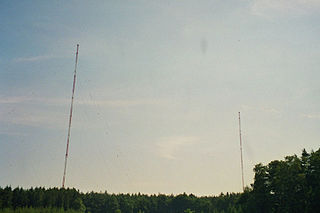
The Sender Donebach was a 500-kilowatt long wave radio transmitter operating on 153 kHz and transmitting the program of German public broadcaster Deutschlandfunk. The facility, which was the property of Media Broadcast, was built between 1965 and 1967 on a former airfield, and entered service on March 10, 1967.

The Longwave transmitter Europe 1 was the oldest privately owned radio station in Germany, situated between Felsberg and Berus/Saar, Germany. It transmitted on 183 kHz with a power of 2,000 kilowatts a French speaking programme, Europe 1 toward France. It was the highest power radio broadcasting transmitter in Germany. Longwave transmissions stopped on 31 December 2019.

The Roumoules transmitter is the main broadcasting facility for longwave and mediumwave broadcasting of Radio Monte Carlo near Roumoules, France and is owned by Monaco Media Diffusion. The 1000 and 2000kW transmitters installed are among the most powerful in the world and can be received well at nighttime throughout Europe.

The Mühlacker Broadcasting Transmission Facility is a radio transmission facility near Mühlacker, Germany, first put into service on November 21, 1930. It uses two guyed steel tube masts as aerials and one guyed steel framework mast, which are insulated against ground. It has two transmission aerials for shortwave and one free standing steel framework tower for directional radio services. The shortwave transmitter was shut off on October 19, 2004. The medium wave transmitter was switched off in January 2012.

The AM transmitter in Burg, near Magdeburg, Germany, is a huge facility for longwave and mediumwave broadcasting. Its most dominant constructions are a 324-metre guyed radio mast and two 210 metre guyed steel tube masts.

The Langenberg transmission tower is a broadcasting station for analog FM Radio and Digital-TV signals. It is located in Langenberg, Velbert, Germany and owned and operated by Westdeutscher Rundfunk, WDR.
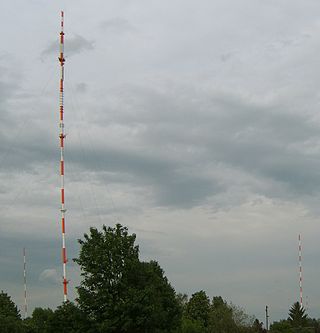
The Transmitter Hamburg-Billstedt is a broadcasting facility in Hamburg-Billstedt, established in 1934. It is owned and operated by the Norddeutscher Rundfunk public broadcasting service, but open to competitors, too.

The Transmitter Ismaning was a large radio transmitting station near Ismaning, Bavaria, Germany. It was inaugurated in 1932. From 1932 to 1934 this transmitter used a T-antenna as transmitting antenna, which was spun between two 115-metre-high free-standing wooden lattice towers, which were 240 metres apart. As this antenna had an unfavourable vertical radiation pattern, which produced much skywave resulting in a too small fading-free reception area at night, in 1934 a new antenna was installed. Therefore, one of the towers was dismantled and rebuilt on a 39-metre-high (128 ft) wooden lattice base. While this work took place, an L-Antenna was used, which was spun between the other tower and a small auxiliary wooden tower. It became defunct in 1977 and was destroyed in 1983.

Transmitter Berlin-Britz was a broadcasting facility for medium wave, shortwave and FM on the site of a former tree nursery in Berlin-Britz. It was established in 1946 and until 1993 it was the most important transmitter of RIAS. It was used by Deutschlandradio until 4 September 2013, and was finally demolished on 18 July 2015.
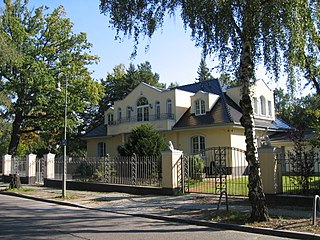
The Transmitter Stallupöner Allee, Berlin is a transmission site for medium wave radio broadcasts situated on the Stallupöner Allee in Berlin-Charlottenburg, Germany. This transmission site was established in 1948. It uses as aerial a 130-metre-high guyed steel framework mast with triangular section, which is insulated against ground. Until 1998 there was a second insulated guyed steel framework mast on the site. It was replaced by a small freestanding steel framework tower. The transmission power of the medium wave transmitter was reduced during the nineties from 100 kilowatts to 2.5 kilowatts.

The Rheinsender is an FM radio transmission site for the German Südwestrundfunk regional public broadcasting system. The Rheinsender is located near Wolfsheim, southwest of Mainz.

The Königs Wusterhausen transmitter was a large transmission facility for longwave, mediumwave and shortwave radio, located near Königs Wusterhausen southeast of Berlin, Germany. Initially built by the telegraph battalion of the German Army, operation began during World War I in 1916. On 22 December 1920, the transmission of a Christmas concert marked the birth of public broadcasting in Germany.

The Transmitter Berlin-Tegel was a broadcasting facility for medium wave in Berlin-Tegel, Germany. It was built in 1933 and used as an aerial wire hung up in a 165-metre-high (541 ft) tower of wood framework. In 1940, the height of the tower was reduced to 86 metres. On December 16, 1948 the tower was bombed under orders of the French Commander at the time, because of concerns of endangering the air traffic of the nearby Berlin Tegel Airport, which was under construction at the time.
The Experimental Radio Station Eberswalde was an experimental radio station of the company C. Lorenz AG founded in Eberswalde, Germany in 1909.
Deutschlandsender Zeesen was a facility for longwave broadcasting near Zeesen, a district of Königs Wusterhausen in Germany. Built by the German Reichspost in 1927, it served the nationwide Deutschlandsender radio transmissions by the Deutsche Welle broadcaster.

The Wiederau transmitter is the oldest broadcasting facility in Saxony. It is located near Wiederau, a village which is part of the municipality of Pegau, and is used for medium-wave, FM and Television broadcasting.
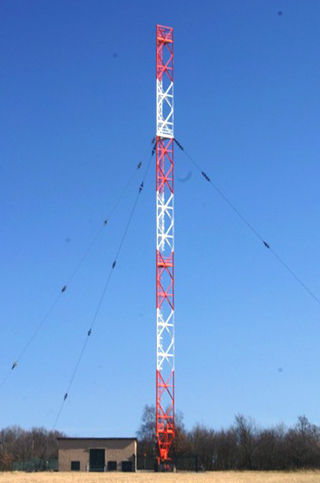
Marnach transmitter was a broadcasting facility of RTL near Marnach in the commune of Clervaux, in northern Luxembourg. The Marnach transmitter was built in 1955 for improving the transmission of the English-speaking program on 1439 kHz, which was transmitted from 1951 with an omnidirectional antenna from Junglinster, to the British Isles and for a better transmission on this frequency to Germany at daytime. Therefore, it was given a directional antenna with a switchable directional characteristic pointing north-northeast towards the Rhine-Ruhr area, Germany's most populated area, and west-northwest in the direction of the UK. This antenna was implemented in form of a directional antenna consisting of three ground-fed 105-metre-tall (350 ft) guyed mast antennas arranged in the form of an isosceles triangle with a 90-degree angle. As transmitters, two 100 kW units switched in parallel were used when it went in service in December 1955.
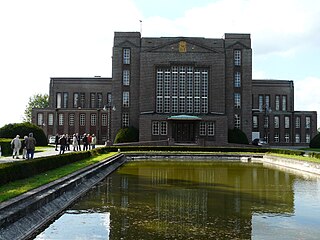
Nauen Transmitter Station in Nauen, Havelland district, Brandenburg, Germany, is the oldest continuously operating radio transmitting installation in the world. Germany's first high power radio transmitter, it was founded on 1 April 1906 by Telefunken corporation and operated as a longwave radiotelegraphy station through World War II, and during World War I became Germany's main link with the outside world when its submarine communications cables were cut. Upgraded with shortwave transmitters in the 1920s it was Germany's most advanced long range radio station, continually upgraded with the latest equipment and serving as an experimental station for Telefunken to test new technology. At the end of World War II, invading Russian troops dismantled and removed the transmitting equipment. During the Cold War it served as the GDR's international shortwave station Radio Berlin International (RBI), and was the East Bloc's second most powerful radio station, disseminating Communist propaganda to other countries. Since German Reunification in 1991 it has been operated by Deutsche Telekom, Germany's state telecommunication service. The original 1920 transmitter building designed by architect Herman Muthesius is still used; it is one of the many remaining buildings designed by that architect that is a protected cultural heritage site.

Zeesen is a village south of Königs Wusterhausen in Germany, known for Deutschlandsender Zeesen, which was built in 1927, and the Zeesen short-wave transmitter.